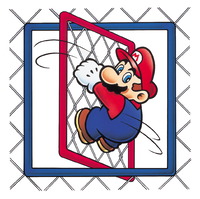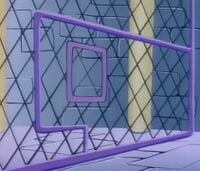Flip Panel (Chain-Link)
It has been requested that more images be uploaded for this article. Remove this notice only after the additional images have been added. Specifics: Sprites/renders of both types of Flip Panels
| Flip Panel | |
|---|---|
 Artwork with Mario from Super Mario World | |
| First appearance | Super Mario World (1990) |
| Latest appearance | Super Mario 3D All-Stars (2020) |
| Variant of | Chain-Link |
The Chain-Link variety of Flip Panels,[1] also known as Revolving Doors[2] or Revolving Gates,[3] are a type of fence-based object that rotates the player and certain enemies to the other side of the fence when hit.
History[edit]
Super Mario series[edit]
Super Mario World[edit]
Revolving Doors first appear in Super Mario World, where they can be found in #1 Iggy's Castle and the second room of Front Door. They are objects attached to fences that, when hit, rotate the player onto the other side of the fence.
Super Mario Sunshine[edit]
Revolving Gates return in Super Mario Sunshine, appearing in certain areas of Ricco Harbor and Pinna Park. One mission, The Runaway Ferris Wheel, involves Mario using a particular Revolving Gate in the latter area to defeat the Electro-Koopa King and obtain said mission's Shine Sprite.
When climbing on vertical Revolving Gates, the player must press ![]() to flip them, but when climbing from the bottom of a horizontal Revolving Gate, the player must press
to flip them, but when climbing from the bottom of a horizontal Revolving Gate, the player must press ![]() instead. To flip a horizontal Revolving Gate from the top, the player must perform a Ground Pound.
instead. To flip a horizontal Revolving Gate from the top, the player must perform a Ground Pound.
New Super Mario Bros.[edit]
Flip Panels reappear in New Super Mario Bros. In this game, they also come in two different sizes; while the small ones have dimensions 2×2 and take roughly a third of a second to flip over, the large ones have dimensions 12×4 and take roughly three quarters of a second to flip over. While two large ones appear in World 3-![]() Tower along with a small one in the area with the level's third Star Coin, numerous small ones appear throughout World 4-
Tower along with a small one in the area with the level's third Star Coin, numerous small ones appear throughout World 4-![]() Tower.
Tower.
New Super Mario Bros. Wii[edit]
Flip Panels return in New Super Mario Bros. Wii, behaving the same as in New Super Mario Bros., though the small ones have dimensions 4×4. Though eighteen appear as the basis of the minigame Power-up Panels, only three others appear in the entire rest of the game, all of which are found in World 4-![]() Castle: A small one appears near the beginning of the level, a large one subsequently appears just after the level's first Star Coin, and another small one appears just before the Warp Door leading to the midway point.
Castle: A small one appears near the beginning of the level, a large one subsequently appears just after the level's first Star Coin, and another small one appears just before the Warp Door leading to the midway point.
Notably, a particular glitch involving the large Flip Panel exists in this game; if the player uses an Ice Ball to freeze a Climbing Koopa, then flips the Flip Panel while the Climbing Koopa intersects it, the Climbing Koopa will fall to the ground and produce infinite coins.
Super Mario World television series[edit]

A single Revolving Door appears in the Super Mario World episode "Mama Luigi," with the baby Yoshisaur jumping through one while Mario and Luigi chase him through King Koopa's Neon Castle.
Mario Party series[edit]
In the Mario Party series, Flip Panels appear only in two games, Mario Party 9 and Mario Party: Star Rush. In Mario Party 9, a handful of Flip Panels of different sizes appear in the minigame Cage Match, where they function identically as in the platform games and are necessary in order to reach Bowser Jr. In Mario Party: Star Rush, six Flip Panels are the basis of the minigame Bowser's Fence Fury, where if Bowser smacks a Flip Panel while a player is on it, they are automatically eliminated from the minigame.
Gallery[edit]
Names in other languages[edit]
| Language | Name | Meaning | Notes |
|---|---|---|---|
| Japanese | Kaiten Tobira |
Spin Door | |
| 回転フェンス[6] Kaiten Fensu |
Spin Fence | ||
Kaiten Kanaami |
Spin Wire Netting | ||
| Korean | 회전문 돌리기[8] Hoejeonmun Dolligi |
Revolving Gate |
References[edit]
- ^ 2006. New Super Mario Bros. instruction booklet. Nintendo of America (American English). Page 21.
- ^ 1991. Super Mario World instruction booklet. Nintendo of America (American English). Page 13.
- ^ 2002. Super Mario Sunshine instruction booklet. Nintendo of America (American English). Page 26.
- ^ 1990. スーパーマリオワールド (Sūpā Mario Wārudo) instruction booklet (PDF). Nintendo (Japanese). Page 16.
- ^ 2002. スーパーマリオサンシャイン (Sūpā Mario Sanshain) instruction booklet. Nintendo (Japanese). Page 26.
- ^ Sakai, Kazuya (Ambit) et al. (October 19, 2015). Super Mario Bros. Hyakka: Nintendo Kōshiki Guidebook, Super Mario Sunshine section. Shogakukan (Japanese). ISBN 978-4-09-106569-8. Page 105.
- ^ 2006.
New スーパーマリオブラザーズ instruction booklet (PDF). Nintendo (Japanese). Page 21. - ^ Super Mario Sunshine Korean manual. Page 35.




